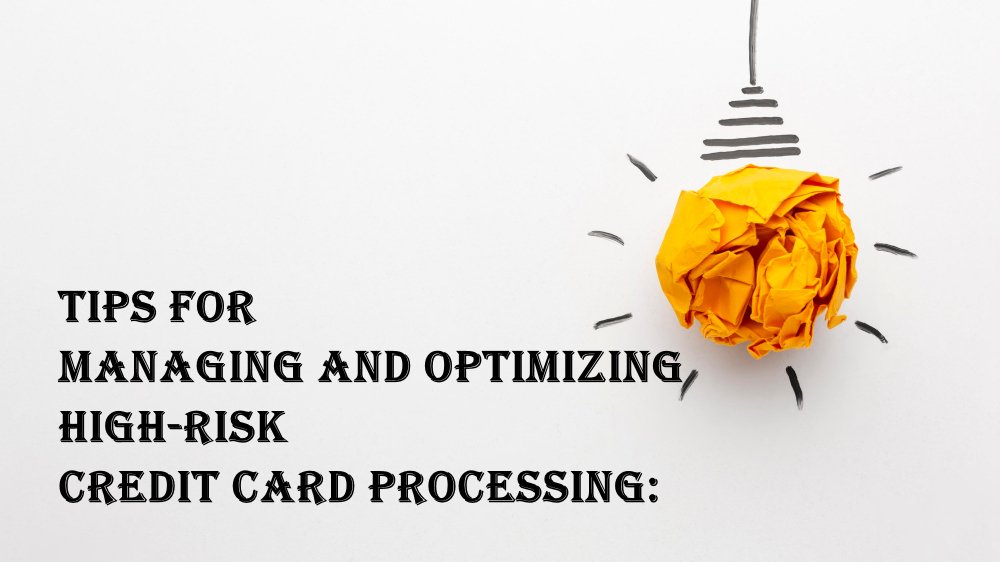How Does High Risk Credit Card Processing Work?

As businesses grow and expand, they face new challenges, including the high risk credit card processing transactions. This process can be particularly complex for some industries due to the higher risk level. High-risk credit card processing is essential for businesses operating in these industries. Must comprehend the details of this process to manage risks and ensure compliance with regulations. This blog will explore how high risk credit card processing work and provide valuable insight for businesses.
Several factors contribute to a business being classified as high risk, including its industry, the potential for chargebacks and fraud, regulatory restrictions, recurring billing models, and previous merchant account terminations.
Risk Assessment and Underwriting Process

It involves processing transactions for businesses considered high-risk by financial institutions. The process includes the following steps:
- Application and Underwriting:
The merchant applies for a high-risk account, providing detailed information about the business. The processor evaluates the application based on industry risk, chargeback ratios, fraud prevention measures, and compliance.
- Approval and Account Setup:
If the application is approved, a high-risk merchant account is set up for the business. The merchant receives payment processing tools and may have specific terms such as higher fees or rolling reserves.
- Integration and Compliance:
The merchant integrates the payment processing tools into their infrastructure and complies with PCI data security standards.
- Transaction Processing:
Customers provide payment details, which are transmitted to the processor for verification. Authorized funds are transferred to the merchant’s account.
- Risk Management and Monitoring:
The payment processor monitors transactions for fraud, excessive chargebacks, and violations. Actions such as withholding funds or terminating the account may be taken if thresholds are exceeded. They must work with specialized payment processors that understand their industry.
You May Also Like: Guide to Navigating High-Risk Processing
Risk Mitigation and Fraud Prevention

High-risk businesses can use several strategies to mitigate risks, including implementing robust fraud prevention measures, conducting thorough customer due diligence, using secure high risk payment gateways and technologies, maintaining transparent refund and cancellation policies, and monitoring and analyzing transaction data.
Effective chargeback management is crucial for high-risk businesses. They should have clear policies and procedures to handle customer disputes, provide prompt and accurate responses to chargeback requests, maintain proper documentation, and check.
What are the Benefits of High Risk Credit Card Processing?

High risk credit card processing is available for these businesses, with many benefits that can help them grow and succeed. Here are some of the top benefits of high risk credit card processing:
1. Increased Revenue
Customers are more inclined to choose a company that accepts a variety of payment choices. It can result in a significant increase in sales and revenue.
2. Fraud Prevention
They come with advanced fraud prevention tools to protect businesses and their customers. These tools can detect and prevent fraudulent transactions and its customers from financial loss.
3. Flexibility
Businesses can accept customer payments using different methods, such as credit and debit cards, mobile payments, and e-wallets. It is made possible through a service known as high-risk credit card processing. By offering many payment options, businesses can accommodate payment preferences.
4. Global Coverage
High-risk credit card processing allows businesses to receive payments from customers worldwide. It can assist companies in growing their customer base and boosting their earnings from international markets.
5. No False Transactions
They have strict underwriting procedures that ensure that there are no false transactions. It helps businesses avoid chargebacks and disputes, which can be costly and time-consuming.
6. Improved Security
They offer advanced security measures that protect businesses and customers from data breaches and other security threats. It includes PCI compliance, encryption, and fraud monitoring tools.
7. Technology Integration
They offer technology integration, allowing businesses to integrate their payment processing with their existing systems. It makes it easier to manage transactions and keep track of payment data.
8. Merchant Underwriting Procedure
They have a thorough underwriting procedure that ensures that businesses are vetted and approved before they can start accepting payments. It helps to protect both the provider and the merchant from potential financial loss.
9. Expansion Opportunities
Businesses can explore new opportunities for growth and expansion. They can reach new markets and offer more payment options to customers, leading to increased revenue and improved customer satisfaction.
Tips for managing and optimizing high-risk credit card processing:

It handles and improves the processing of credit cards that carry higher risks, and businesses need to do the following:
- Conduct research and choose payment processors who have expertise in serving industries that are considered high-risk.
- Implement robust measures to prevent fraud, ensuring the safety of transactions.
- Check and assess chargeback ratios to understand and manage potential risks.
- Provide excellent customer service and clear communication channels to address concerns or issues.
- Review and adjust risk mitigation strategies to manage potential risks.
Future Trends and Innovations in High-Risk Credit Card Processing
- Advancements in fraud detection and prevention technology:
Technological advancements will likely improve fraud detection and prevention solutions. These may include AI-powered algorithms, machine learning models, biometric authentication, and enhanced data analytics to identify and prevent fraudulent transactions.
- Evolving regulations and compliance requirements:
Changes in regulations and compliance requirements may impact high-risk credit card processing. Businesses must stay updated on these changes and ensure ongoing compliance to mitigate risks and avoid penalties.
- Emerging payment methods for high-risk merchants:
High-risk merchants may enjoy the emergence of alternative payment methods. These can include digital wallets, cryptocurrency payments, and other innovative solutions that offer more options for customers and reduce certain risks associated with traditional card payments.
FAQs
1. What industries are considered high-risk for credit card processing?
Industries considered high-risk for credit card processing include online gambling, adult entertainment, travel, nutraceuticals, and e-commerce.
2. How do I know if my business is considered high-risk?
If your business operates in a high-risk industry, has a history of chargebacks or fraud, or has a poor credit history, it may be considered high-risk.
3. What documentation must I provide for high-risk credit card processing?
The documentation required for high-risk credit card processing may vary depending on the provider and your business’s circumstances. However, you may be required to provide documents such as business registration, financial statements, and proof of identity.
4. Can high-risk credit card processing help me reduce chargebacks?
High-risk credit card processing providers offer chargeback management tools and fraud prevention measures to help reduce chargebacks.
5. Is high-risk credit card processing more expensive than standard credit card processing?
High-risk credit card processing comes with higher fees due to the risk involved and the more security measures required.
6. What should I do if my high-risk merchant account is terminated?
If your high-risk merchant account is terminated, you may need to find a new provider. Make sure to research providers and choose one with experience working with businesses in your industry.
Conclusion
High-risk credit card processing can provide a lifeline for businesses operating in challenging industries or with a history of financial difficulties. However, choosing the right provider and being aware of the potential risks and costs is crucial. By considering your business’s needs and priorities and conducting thorough research, you can find a high-risk credit card processing solution that will help you navigate the unique challenges of your industry while safeguarding your financial stability and ensuring optimal customer experience. By doing so, you’ll be in a better position to succeed and thrive in even the most demanding business environments.
Recent Posts
- Securing Your Small Business: Best Practices in Payment Security
- How Small Business Merchant Services Can Boost Your Bottom Line?
- The Impact of E-commerce on Small Business Merchant Services
- How Merchant Services Can Support Growth for Small Businesses
- Unlocking the Potential: The Pros and Cons of Open Source Retail POS Systems
Recent Comments
- Could a High Risk Merchant Account be the Solution for Small Businesses? on How Does High Risk Credit Card Processing Work?
- Could a High Risk Merchant Account be the Solution for Small Businesses? on Low Risk Vs High Risk Payment Processing
- Could a High Risk Merchant Account be the Solution for Small Businesses? on How to Get a High-Risk Merchant Account in the US?
- How Does High Risk Credit Card Processing Work? on How to Get a High-Risk Merchant Account in the US?
- How Does High Risk Credit Card Processing Work? on How to Get a High Risk Payment Gateway?
Comments are closed.